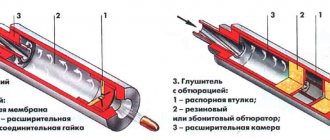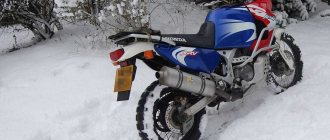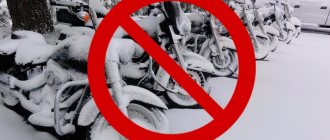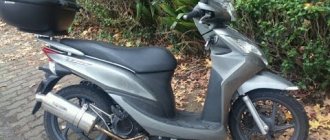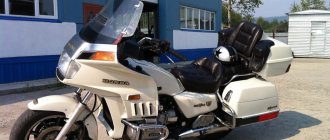If you know the slogan “Let freedom ride”, and the name Jackson Teller is not an empty phrase for you, then this article is for you. There are no former motorcyclists: once you feel the spirit of freedom, you will invariably strive for it again and again: the roar of a classic American engine, the wind flying into the sleeves of a biker jacket, and the empty highway ahead... Wait, maybe this is not your story at all? Maybe you are one of those who are used to seeing only a three-digit number on the speedometer and hearing not a roar, but the incomparable roar of Japanese engines? Kawasaki or Harley Davidson, Yamaha or Indian, any motorcycle deserves care and proper storage. We'll tell you how to properly store your bike and where it's best to do it.
Seasonal motorcycle storage: main features
Even if you know all the intricacies of preserving motorcycle equipment for the winter, the question of storing a motorcycle always makes every self-respecting motorcyclist think. Here the selection of options begins: a garage, a parking lot, a street, a shed in the country, in the end - where to choose your favorite bike? We must remember that the main enemy of any motorcycle is moisture. In a matter of days, it can begin corrosive processes, which will then be very difficult to get rid of. Temperature changes and cold also have a bad effect, so winter storage of a motorcycle is a separate topic that deserves detailed instructions, in addition to the fact that we will tell you where you can store a motorcycle in the summer.
www.pinterest.com
Conservation
Preserving a motorcycle for the winter is its complete maintenance, which includes changing the oil, flushing the gas tank, checking all the wires and much more, which will allow you to immediately get on the bike in the spring and start it halfway.
Don’t rush to the garage, first you should go to the store and buy everything you need to process the motorcycle. This:
- Silicone Grease;
- spray for metal surfaces, or more simply put, the well-known “Vedashka” WD-40;
- chain lubricant;
- wax polish or simple lubricant;
- new motor oil;
- rags;
- a can of gasoline;
- additive for cleaning the fuel system.
Let's start with the hottest thing - gasoline! Leaving a motorcycle with a half-empty tank for the winter means dooming it to inevitable corrosion, don’t do that. The motorcycle should be preserved with a filled tank so that condensation does not appear on its walls, causing corrosion.
Need I say that it is better to refuel with high-quality gasoline with the octane number for which the engine is designed? Take the time and money to find proven fuel. If you are not sure about the gasoline that is splashing around in the gas tank, then it is better to drain it completely and fill it with good, high-quality fuel. Since gasoline, like any other hydrocarbons, is unstable and decomposes after some time, and higher fractions quickly evaporate, the shelf life of gasoline at gas stations does not exceed 30 days. What to do? You can add a fuel stabilizer to gasoline or a special additive to clean the fuel system - this can be done right at the gas station, without leaving the cash register, as they say, or rather, from the motorcycle.
Then the motorcycle needs to be washed. Here you can go two ways: do everything yourself in the garage or go to a car wash. Just not contactless! In most cases, they use products with very aggressive alkaline compounds that do not provide a protective coating and do not wash away dirt and hard-to-reach places. This means that it is in them that corrosion will appear. Use products with protective wax for hand washing motorcycles - these shampoos are specially created to ensure that the bike's coating does not deteriorate, does not rust, and remains clean for as long as possible. After a refreshing shower, we wipe the bike dry - everything is like people do.
Now you need to process the main nodes. We lubricate all cables, hinges and handles with engine preservation spray or universal WD-40. Particular attention should be paid to the front fork and lubricate the chrome feathers.
Next we protect the electrical wiring. The main enemies of wiring: sub-zero temperatures (terminals oxidize), humidity and dampness (materials wear out), rodents (gnaw and damage wires). A special spray for treating electrical wiring will protect you from all these problems: it lasts for just six months, and for every firefighter, we spray high-voltage wires with a spray against rodents - the smell will scare them away, not even allowing them to try the wires. Silicone lubricant will protect the rubber from hardening, cracking and aging.
Tire treatment cannot be skipped if you want the rubber to last for a long time: in the winter, be sure to treat it with special foam. The motorcycle's rubber is special, its composition is soft, so that the bike has high grip on the road when turning and leaning. It hardens and dries quickly, so regular silicone will not work here. Tire foam will keep the rubber as soft and wear-resistant. And don’t forget about the tire pressure: it must be reduced to 0.5 atmospheres.
Removing the battery. At this stage, even the most seasoned biker will wipe away a stingy tear: we disconnect the motorcycle from the power supply, that is, we remove the battery. If you do not remove the battery, but simply decide to remove the terminals from it, then treat them with a protective spray to prevent corrosion.
How to protect a motorcycle from theft?
When buying a new bike, the first thing owners think about is how to protect the motorcycle from theft. There are many different ways to ensure the safety of your bike. We'll talk about them.
Of course, in our time, thefts do not occur so often, but you should not leave your pet unattended. New bikes are much more difficult to steal than those made more than a decade ago. However, there is a possibility of ending up in such a situation. A good bike security system should consist of two components: a notification to the owner and an ignition lock. To these two components you can also add a mechanical lock, which will eliminate the possibility of moving the motorcycle (for example, if they want to take it away).
In addition to security systems, it is worth paying attention to the location of the motorcycle. Leaving it in dark corners where no one goes is extremely imprudent. It's better for him to be in plain sight. Such places can be called parks, playgrounds and the like. What devices exist to protect a bike? There are quite a few of them, let’s look at the main ones.
Mechanical interlocks
Castles are known to everyone and are easily accessible. There are a huge variety of them, from chains and cables, which are often used by cyclists, to disc locks. An anti-theft motorcycle chain is the cheapest option and is also quite effective. However, seasoned thieves have long known ways to saw through a chain or pick a lock.
For these reasons, mechanical interlocks have certain requirements:
- The keyhole must be unique to prevent the key from being matched. Nowadays, there are universal keys that can break a lock with a standard cam system.
- Materials for locks must be made of high-strength materials.
- The lock must be secured as inconveniently as possible for breaking, i.e. the keyhole should be located close to the obstacle.
- The thicker the chain, the better. A strong chain is much more difficult to bite or break. Therefore, a chain made of durable heat-treated steel will be an excellent obstacle to theft.
The only disadvantage of mechanical blockers is the inconvenience of use during frequent use in urban environments. Each time removing and installing a chain with a lock is inconvenient and time-consuming. Otherwise, this is an excellent way of protection.
Alarms with engine blocking
This is the most pleasant protection for a motorcycle against theft. It does not take time, works at the press of a button and is a very reliable protection option. Such a security system will notify you and everyone around you about a break-in attempt. It is unlikely that anyone will decide to steal a bike when many people are looking at it. In addition, progress has also been made to the ignition switch. Now, when the alarm is triggered, the engine is automatically blocked. Even if there are no witnesses around, the attackers will not be able to start the engine.
Conventional alarms
The least popular way to protect a motorcycle from theft. Such a system is a separate monoblock with its own battery and alarm signals. It is small in size and equipped with an emergency start system to continue operation even with a dead power source. You can adjust the sensitivity and set control from a distance. The difference between such a system is its relatively high price with low reliability. Cars are the basis of alarm systems, so developing systems for motorcycles is quite unprofitable for manufacturing companies. This is why prices are rising every year.
Such protection is provided rather for inexpensive units (scooters, mopeds, etc.). They consume less electricity, so low-capacity power supplies are installed that can provide current charging for simple signaling. Thus, low protection requires the installation of additional sensors. However, it consumes additional electricity.
Small dimensions allow the system to be used on any motorcycle. It is only necessary to seal the device for weather resistance.
Advanced defense systems
Unfortunately, there is still no universal security system suitable for any type of transport and including all aspects of protection. However, more recently, autonomous operating systems have emerged that provide reliability even when the battery is dead. The peculiarity of this phenomenon lies in the on-board computer, which, when the engine starts, sends a charge to the monoblock and an additional power source for the alarm. This ensures the system operates for a long time.
For greater effect, it is worth combining mechanical interlocks and simple alarms. For an urban option, this method may be an excellent option.
Checking a motorcycle for theft
Checking your motorcycle for theft is a very important step before buying a new bike. Since motorcycles are much more likely to be stolen than cars, it is quite easy to stumble upon a stolen unit. Therefore, before purchasing, you should definitely have the motorcycle checked for theft.
In general, there are many databases that are available on the Internet. They are based on traffic police records of stolen vehicles. In order to find out whether a vehicle has been stolen, you need to know its VIN number. This is an individual code issued to any vehicle when it is created at the factory. Each motorcycle or car is unique. Therefore, when stolen, the owner leaves all the data about the motorcycle. In addition to the Internet, you can contact the traffic police directly. Their database is updated as applications are received, making the verification more reliable.
This is the most effective way to check a motorcycle for theft. Of course, the best option would be not to deal with dubious sellers and suspiciously low prices. If the owner does not have documents for a relatively new motorcycle, then there is a high probability that it does not belong to him.
Where is the best place to store a motorcycle?
You need to choose a storage location carefully - it should be safe, warm and ventilated. We don’t consider options for storing a motorcycle on the balcony, landing, in the front door, under the mother-in-law’s bed, in a missile warehouse, or in the basement of a nearby store - all this is not serious. Any self-respecting motorcyclist will make every effort to take the best possible care of his equipment. Let's go through the most common storage options and see where it is best to keep a motorcycle.
Other transport storage places
Due to the fact that the presence of a motorcycle implies not only the vehicle itself, but also its components, namely spare parts and tires. It is also important to have room for repairs. If you have a high-class two-wheeled friend and store it in the open air, you can incur considerable losses. It is best to purchase a garage or rent one. If funds do not allow you to do this, you can organize a cooperative with familiar motorcyclists. How? By cooperating into a target group, they rent a place to store motorcycles - this will significantly reduce costs. By getting more serious about organizing the location of your bike, you can install heating and equip it for your convenience.
If there is any enterprise near the house, it is worth agreeing with its owners about temporary parking. This also applies to any large facility where security is provided. These include:
- production company;
- shop;
- furniture workshop;
- abandoned premises.
Thus, using such areas located near the house, you can store your funds on mutually beneficial terms.
Street
The simplest option in every sense is to chain your iron friend to the bars under the windows of your home. Of course, you will need a good strong chain or a special anti-theft bracket with an alarm, a case, as well as constant supervision of the motorcycle. This will not protect the motorcycle from vandals, bad weather or theft, but if you are lucky, the money saved from paid parking or garage rental will be able to buy new protection for the next season. If, of course, there is still anything left of the motorcycle.
Winter⛔
Summer✅
Pros: free, motorcycle is always at hand.
Cons: unsafe; in bad weather it will begin to deteriorate.
Warehouses - motorcycle showrooms and services
According to experts, this is the best way for winter recreation for all motorcycles that do not have access to a private heated garage. Cars for wintering are a constant offer at almost all car dealerships, as well as a large group of motorcycle services. The biggest advantage of this solution is the almost complete peace of mind of the owner. The car is stored in a heated and, importantly, insured premises with protection and control - the owner does not need to worry.
Another advantage of this solution, especially in the case of motorcycle services, is the possibility of commissioning a complete service of the machine. Contrary to popular belief, motorcyclists do not fall asleep in winter. By providing them with a vehicle to store, owners can rest assured that they will take care of the condition of the battery and carry out a comprehensive check in the spring.
You can also ask for a full service with fluid and filter changes, which is definitely a very good idea. Thanks to this, in the new season, trips will begin on a fully serviceable and prepared motorcycle.
Storage and winter storage services are, of course, paid services that will always be more expensive than random places you find on your own. However, given the nature of the motorcycles, their high cost coupled with the ease of theft and the need for periodic maintenance, it is a valuable investment that will see owners repaid within the next season.
Garage
An unheated garage is harsh, but better than outside, and your two-wheeled friend will definitely say “thank you!” for a heated garage. In the garage, the motorcycle will no longer be covered with snow and it will not get wet in the rain, however, when stored in a cold room, the spark plugs may turn sour - they should be unscrewed in advance; in a warm garage there will be no such problems. Motorcyclists are a strong community and are used to helping each other and helping out in difficult times. Therefore, many bikers pool together to rent a garage for their car in order to put several bikes there at once: it’s both cheaper and easier.
Winter✅
Summer✅
Pros: under a roof, under lock and key.
Cons: in an unheated garage, even a motorcycle prepared for preservation is not protected from corrosion.
Paid parking
This is one of the safest options: for a relatively small fee, the motorcycle will be under supervision 24/7 and no one will be able to encroach on your property without permission. Unfortunately, rain, snow, low temperatures and humidity will undoubtedly have a negative impact on the condition of the motorcycle in an open parking lot. Heated parking is the answer to the question: “Where to store a motorcycle in the city?” Ideal climate, security and the opportunity to visit your friend at any time.
Winter✅
Summer✅
Pros: safe and ideal storage conditions.
Cons: high price and danger of corrosion in the case of open parking.
Container
A motorcycle storage container is a sealed metal box that is quite mobile (can be moved if necessary) and sealed. All the pros and cons in one bottle. Yes, it’s easy to install a container in your local area, but intruders can also do this - that is, take and drag away your container along with the motorcycle inside. Airtightness, on the one hand, seems like a plus - it protects against weather conditions, but in reality, the lack of ventilation can contribute to improper humidity, condensation, mold, etc. Ventilation is an important point when storing a motorcycle for a long time.
Winter✅
Summer✅
Pros: the container is easy to install and move by yourself, protects from snow and rain.
Cons: not heated, not ventilated, not very reliable.
House or apartment
Although it sounds like something from outer space, the Internet is full of photos posted by motorcyclists who proudly display their cars as part of their winter home decor. If the "iron horse" is quite young, without leaks, it should not emit any obvious odors. Of course, the low-key aroma of gasoline is something that motorcyclists really enjoy, but it can cause problems with other family members.
There may also be some difficulties in delivering the motorcycle to the upper floors if the elevator is not of sufficient size.



